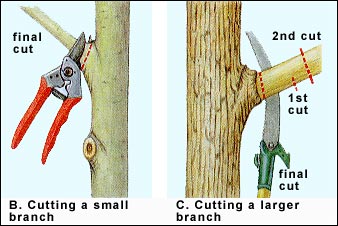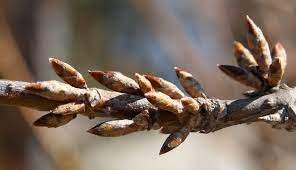They’re naked! Trees and shrubs, what to prune and when to wait


Forsythia buds ready to open Do not prune spring blooming shrubs now.
You know the old phrase, “timing is everything?” Not to sound like a politician, but in gardening, it is and isn’t.
Can you transplant, spray, seed, or prune any time of the year? Sure. But you get better results if you target the ideal time. And while the deciduous trees and shrubs are “naked;” it is the ideal time to prune many, but not all of them. Here is what you need to know:
First, what not to prune now. You can’t see it, unless you look really closely and know what to look for, but all of the spring blooming shrubs should NOT be pruned until AFTER they bloom. These include including forsythia, lilac, mock orange, weigelia, azalea, rhododendron, kerria and fothergilla.
Often well-meaning, get-a-jump-on-things gardeners, make the mistake and go a little pruning-happy and prune these shrubs in winter. Guess what? You have just cut off all of your flowers for spring. Technically it won’t kill or harm your plant, but who grows a lilac for the leaves?
What you want to target with mid-to-late winter pruning are the deciduous (that means the ones that lose their leaves in the fall) trees and shrubs that are not spring-blooming. The beauty of winter pruning is you can clearly see the “bones,” or structure of the plants.
There are several rules of pruning. First, anytime anything is dangerous, remove it, even if it is a spring-blooming shrub. Personal safety is paramount. You may be used to walking around that low-hanging branch on the bushes by the front door, but what about visitors? Prune it off.
When looking at trees and shrubs for safety. If it involves being near a powerline. Just don’t. If it is in a common throughway, contact ComEd. If it is in your personal property, contact a professional arborist. I know it is easy to think that one branch isn’t that close to the powerline, but you don’t want to be mistaken and pay for it with your life.
The same is true for pruning of any kind that is not accessible. You know that person, the one who doesn’t have a ladder quite tall enough to reach what they want to prune, so they put the ladder in the bed of their pickup. And it is still not quite tall enough, so they decide to stand on the very top of the ladder where it clearly says, “Do Not Stand,” and then on tippy toes, with a pole pruner that has seen better days, they set out to prune. Just don’t.
There is actually a famous, sad story of a professor of arboriculture (trees) who, like us, just didn’t want to spend that extra money to prune and ended up, falling and a quadriplegic. No tree and no amount of money is worth that. So, to find an arborist, google http://treesaregood.com That is the International Society of Arboriculture. These people are licensed and certified, and have taken serious tree classes, as well as physical agility hands-on pruning tests to assure they aren’t Jim-Bob with a chainsaw.
You know that person, they are your sister’s boyfriends’ cousin’s neighbor who got a chainsaw for his 16th birthday. No. Do not hire them. Choosing a certified arborist assures you not only knowledge about trees and pruning, but safety.
Other than pruning for dangerous situations. The next issue is crossing branches. When you look into a tree or shrub, regardless of the shape of the plant, all of the branches should be growing outward from the center. If any are growing inward, they will eventually cross another branch. And as branches grow, they get wider in girth (gee, just like me!) and the result is branches will start rubbing against each other. This damages the bark and causes open wounds for diseases and insects an opportune situation for entry.
Once dangerous or crossing branches are removed, now look for any damaged areas. This can often be insect or disease-related, but before you start cutting off something that looks odd, look up your tree/shrub natural characteristics. I have had many a homeowner call me after they chopped large trunks off of their River Birch because they said something was wrong with the bark: It was pink and peeling. Guess what? It is supposed to be. That is why landscapers gave you that tree, for the beautiful exfoliating bark.
If you don’t know what kind of tree/shrub or any plant really, that is what we are here for. Send me pictures or bring in a branch and we can give you all the information you need to know. Email me at [email protected], or mail me or visit our office at 100 Manhattan Road, Joliet (in the Will County Farm Bureau). Our mission, remember, is Helping Others Learn to Grow.
Now onto the shape of the plant. Before you decide you want to make a Mickey Mouse out of that shrub of yours, realize there are natural shapes to all trees and shrubs.
Some trees grow like a lollipop shape — the trunk is the stick, and the canopy is a big ball. Some are vase- shaped like a bridal wreath spiraea. Others are round. Pruning should only be used to maintain and enhance these shapes, never to create something it is not. Nature will always fight back to regain its natural shape.
And finally, there is an old adage that is true, when is the right time to prune? When the saw is sharp. Be sure your pruning tools are right for the job and appropriately sharpened.